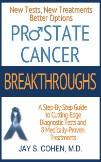Prostate Cancer Breakthroughs - Questions with Dr Jay Cohen

Questions with Dr. Jay Cohen, Author of:
Prostate Cancer Breakthroughs:
New & Better Approaches to Prostate Cancer
1. Prostate Cancer Breakthroughs? This book involves a very different medical problem than your other books and medical journal articles have addressed.
When I was diagnosed with prostate cancer in December 2011, I was told I needed surgery or radiation by four highly respected and knowledgeable doctors.
While waiting for the surgery, I decided against writing a book because I didn't want to think about it any more than necessary. My mind was already reeling, worrying about the cancer as well as the surgery and its potential impact on my sexual and bladder functioning. I have a rare and severe nerve disease in my legs, and there are a lot of medications I cannot take including Viagra and similar drugs.
While waiting for the surgery, I went to a men's support group (IPCSG.org) and learned that there were new tests I could get to more accurately diagnose my condition. The tests completely changed the picture. I took myself off of the surgery schedule and have been doing very well for nearly two years. Knowing that each year, tens of thousands of men with prostate cancer get surgery or radiation they don't really need, I decided I had to get the word out to other men.
2. Many major medical associations have come out against PSA testing. Should men over 50 continue to get an annual PSA test?
PSA stands for prostate specific antigen, a protein produced by normal prostate cells but in larger quantities by prostate cancer cells. Therefore, an elevation in PSA may indicate prostate cancer. The problem is, PSA levels also increase with a large prostate, prostate infection, or other causes.
Too often doctors overreact to an elevated PSA level and rush men to unnecessary biopsies and surgery or radiation. Massive overtreatment is rampant. This problem has led many medical associations to tell doctors to halt annual PSA testing, as if this will make prostate cancer disappear.
Every doctor I have spoken to disagrees with this policy. So do I. It is senseless. PSA is our only routine early warning test for prostate cancer, and early warning is the key to successful treatment. If all doctors stop ordering PSA testing, more than 25,000 additional deaths from prostate cancer will occur annually.
This disease already is the second most common cancer in men, and the second most deadly: 30,000 American men die from prostate cancer each year, and 280,000 worldwide. My advice is that all men over 50 should request an annual PSA test. Men at higher risk, such as those with a blood relative who's had prostate cancer or men who are African-American, should begin getting an annual PSA test at age 40.
3. How do I keep my doctor from overreacting to a high PSA test?
First, always repeat the test. Second, have your doctor perform a digital rectal exam, looking for any abnormalities or lumps that might indicate cancer, or areas of tenderness that might suggest infection. Infection is the most common cause of an elevated PSA.
If there are indications of infection, a course of antibiotics may be in order. And while he is examining you, have him measure the size of your prostate with a small ultrasound device. A prostate gland enlarged over 40 millimeters sometimes causes an elevated PSA result.
4. What is the best thing to do if my doctor recommends a biopsy?
Major cancer centers like Mayo Clinic, Sloan-Kettering (NYC), Johns Hopkins, University of California medical centers in San Francisco, Los Angeles, and San Diego, and others are now doing "targeted biopsies." The problem is that most doctors are still doing the standard, random ("blind") biopsies.
The difference is that targeted biopsies use advanced, dynamic contrast-enhanced (DCE) or multiparametric MRIs to locate areas that might be cancerous, and this allows doctors to target these areas with the biopsy needles. This is a far more accurate method than today's outdated blind biopsies without MRI technology.
If a blind biopsy finds no evidence of prostate cancer, doctors routinely repeat the biopsies. No man wants to do unnecessary biopsies, and there are significant risks. The new approach avoids this. And if the MRI shows no evidence of cancer, the biopsy may be postponed.
5. My biopsy shows prostate cancer with a Gleason grade of 6. What does this mean?
The Gleason number reflects the score given by the examining pathologist to your prostate cancer's level of aggressiveness. The score consists of two numbers, each reflecting one of the two lobes of the prostate.
If you have prostate cancer with a Gleason score of 6, this means your cancer is low-risk, that is, less aggressive. Gleason 7 represents intermediate risk, and Gleason scores 8 to10 represent increasing degrees of highly aggressive cancer. These determinations are the key to making accurate treatment decisions. All too often, doctors recommend surgery or radiation to men with low-risk prostate cancers.
This is the most problematic area of prostate cancer care today: of the 100,000 men who receive surgery or radiation each year, only 15,000 really need these aggressive treatments. These therapies are not benign: tens of thousands of men are left with serious, sometimes permanent impairments to their bladder and/or sexual functioning.
6. Why does overtreatment occur so often?
First, most doctors are still stuck in the 20th century in their approach to prostate cancer. Many have not even heard about the new DCE or multiparametric MRIs. My own urologist refused to order one for me.
Second, most men are so upset when told they have prostate cancer, they thoughtlessly rush into treatment. I call this the “get it out now!" syndrome. Yet most prostate cancer is slow growing, so there nearly always is time to obtain the new tests and, if necessary, second opinions.
Most men and their families think surgery or radiation is a cure. Yet the cancer returns 25% of the time after these treatments. The best results are with a complete diagnostic evaluation including the new tests I describe in Prostate Cancer Breakthroughs. Then treatment decisions can be made with complete information.
7. Do I have other choices instead of surgery or radiation?
If your prostate cancer is low-risk with a Gleason score of 6, you have multiple choices. Many experts today warn against aggressive therapy for Gleason 6 prostate cancer. The death rate without treatment for Gleason 6 prostate cancer is only 2% after 10 years.
At the same time, many men with low-risk prostate cancer still desire treatment. Now that the new MRIs allow us to visualize a man's cancer, there are many new treatment choices with fewer risks than surgery or radiation.
8. How can I avoid overtreatment?
The reason so much overtreatment occurs is that most doctors are very worried about under-treating a man with prostate cancer and having him die unnecessarily. The result is that they over-treat thousands upon thousands.
To be fair, until now doctors haven't had adequate tools. They have had to rely solely on PSA levels and biopsy results to make treatment decisions. Most doctors today do the same.
Yet these two tests are not adequate for making accurate diagnoses. That's why the new DCE-MRIs and parametric MRIs are such huge game changers. This is why all of the major cancer centers in the U.S. are obtaining and implementing this technology.
Another method for seeing into the prostate is the color Doppler ultrasound, which can be done in a doctor's office. About 20 doctors in the U.S. have this device. Obtaining the right tests is the key to making good treatment choices and avoiding overtreatment.
9. I have low-grade prostate cancer that has been confirmed by DCE-MRI and targeted biopsy. My doctor is recommending active surveillance, where we will observe the cancer. Is active surveillance an effective approach?
The majority of men have low-risk prostate cancer, and active surveillance is a very legitimate approach today. I would not say this before the availability of the new diagnostic tests.
But now that we can combine PSA testing every three months with regular MRI scans and, if available, color Doppler ultrasound scans, doctors are much more able to monitor the activity of your cancer.
Dr. Mark Scholz states that 70% of men with low-risk cancer never require active treatment. In the other 30%, low-risk cancer grows so slowly, it can almost always be identified and treated before it becomes a problem.
10. I am uncomfortable with the idea of having cancer in my body. Are there other choices between aggressive treatment and no treatment?
My book, Prostate Cancer Breakthroughs, describes three focal treatments that can remove a localized tumor without removing the entire prostate. These methods are similar to women who choose lumpectomies for their breast cancer.
The three methods are: cryotherapy (a freezing technique), focal laser ablation (a burning technique), and high intensity focused ultrasound (HIFU, available in Canada and overseas, and in the U.S. in a couple of years).
These methods are done today using DCE-MRI imaging and targeting. Early studies indicate high rates of success with far fewer adverse effects that surgery or radiation.
11. I have a high-risk, Gleason 9 cancer. My doctor recommends prostate surgery. What do you think?
Prostatectomy or radiation therapy is often appropriate for high-risk prostate cancer. When considering prostatectomy, it is vital to be sure that the cancer has not spread beyond the prostate gland into lymph nodes or bone. If the cancer has spread, prostatectomy will be ineffective.
There is a new test approved in 2013, the Carbon-11 PET/CT scan, that is far superior to previous tests at identifying metastatic prostate cancer. Androgen deprivation therapy (ADT), which blocks the testosterone that feeds prostate cancer, is another choice you might ask about. It is sometimes used in high-risk prostate cancers before, during or after treatment with surgery or radiation.
Also, for men with metastases to bone but nowhere else, there is a new treatment, Alpharadin, that sends radioactive particles specifically to prostate cancer cells in bone.
Jay S. Cohen M.D. is a prostate cancer survivor, faculty member at the University of California, San Diego, and author of Prostate Cancer Breakthroughs (2013).

October 2013






